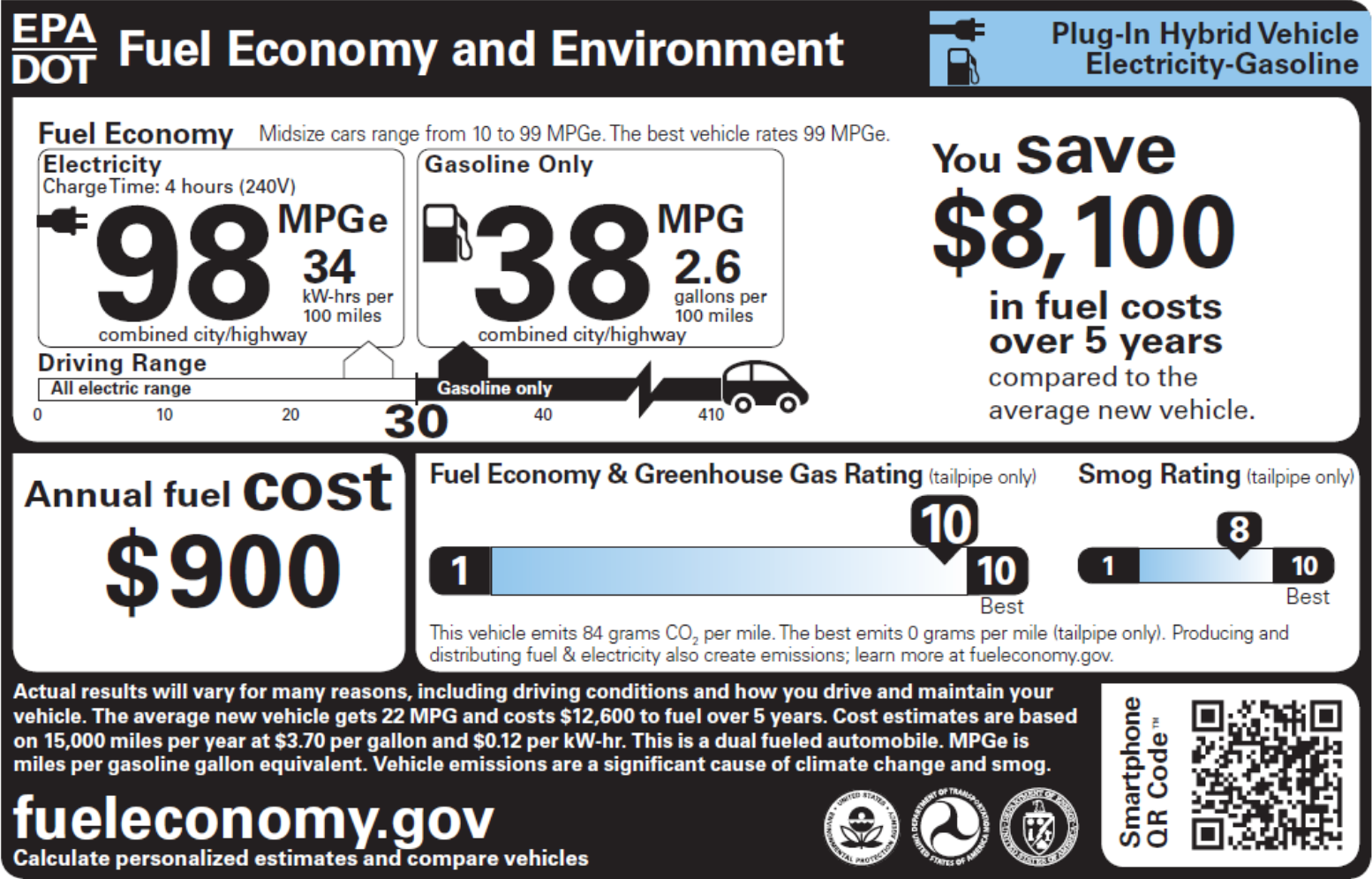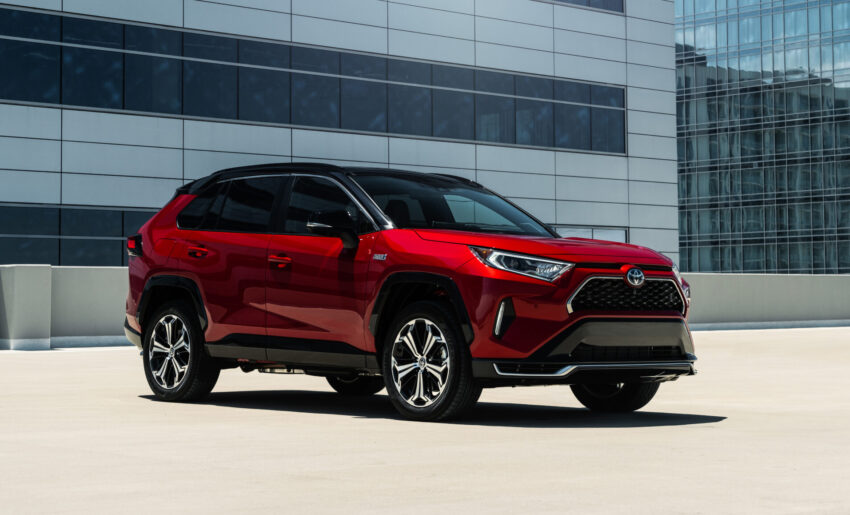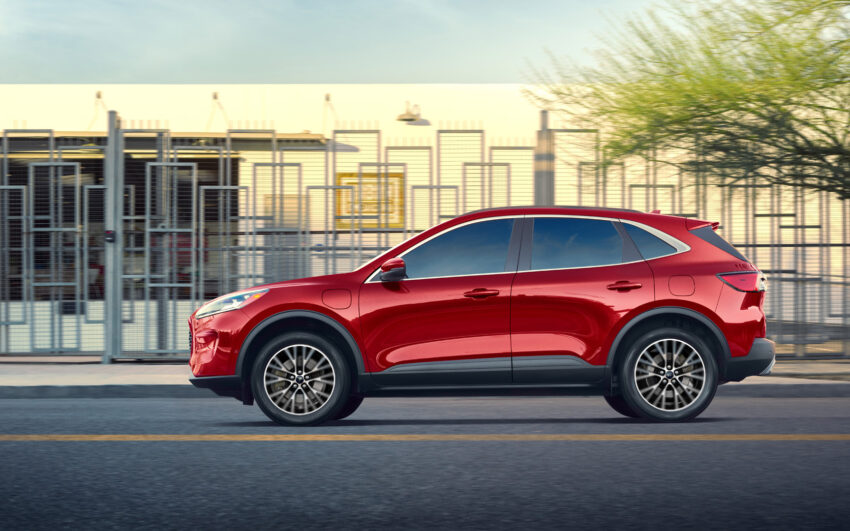
Is it 98, or 38, or do you add and divide by 2? Or something else? Fuel economy isn’t as easy as ABC when dealing with plug-in hybrids.
Miles-per-gallon is a pretty simple concept. Make it MPGe, though, and things can get complex.
The rise of the plug-in hybrid – there are nearly forty 2020 and 2021 models in the market now, a dozen more than in 2019 – has brought MPGe into prominence. Automakers with PHEVs like to advertise it, as do their dealers, because it’s usually an impressive number, especially compared to a gasoline-only version of the same model.
[Estimated reading time: 7 min.]
The Ford Escape PHEV, for instance, has the best MPGe rating of all plug-in hybrids at 100 MPGe, versus 41 mpg combined city-highway for the conventional hybrid version and 30 mpg combined for the gas-only model.
But don’t be taken in.
For plug-in hybrids, MPGe is a theoretical that can’t be achieved unless the vehicle’s gas engine is never used.
What MPGe Is
MPGe – or miles-per-gallon-equivalent – is a fuel efficiency measurement reserved for vehicles, mostly plug-in electrified vehicles, that don’t use gasoline for all or part of their propulsion needs.
(While common in automotive writing to use lower case acronyms, such as mpg for miles-per-gallon, MPGe is used to denote-miles per-gallon-equivalent. It’s MPGe instead of mpgE or mpg-e because the former looks better in print.)
Every fuel, or fuel carrier such as the hydrogen used in fuel-cell electric vehicles, has an energy equivalent that equals the energy stored in one gallon of regular unleaded gas.
For electricity, the equation used by the federal Environmental Protection Agency is that 33.7 kilowatt-hours of electrical power equals the 115,000 BTU (British thermal units) of energy in a gallon of gas with 10 percent ethanol – the common U.S. blend.
Compressed hydrogen used in fuel-cell electric cars is measured by the kilogram, with one kg equal to a gallon of gas.
For most other alternative fuels, the energy content can be measured, like gasoline, in BTUs. A gallon of E85 ethanol, for instance, provides 81,800 BTU, equal to 0.711 gallon of gas.
TheGreenCarGuy deals mainly in electrified vehicles, though, so that’s what we’ll stick with.
For plug-in vehicles – and fuel-cell electrics – MPGe can be a useful shopping tool.
It is displayed on the window sticker of every new plug-in vehicle and lets you compare the relative efficiency of the electric powertrain in the models you’re cross-shopping.
Fuel cell vehicles’ efficiency is measured in miles per kilogram of hydrogen, but is displayed as MPGe instead of MPkg.

2021 Toyota RAV4 Prime 
2020 Ford Escape Plug-In Hybrid
EVs are Easy
For battery-only electric cars and crossovers, or EVs, the MPGe rating, is a pretty easy conversion to make and to understand.
An EV that can go 100 miles on 33.7 kWh gets an EPA rating of 100 MPGe.
Not all electric motors and powertrains are equally efficient, though, so some EVs are rated higher than 100 MPGe, and some are rated lower.
The most efficient EV on the market in the U.S. today is the Tesla Model 3 Standard Range Plus.
The EPA says it can travel 100 miles on just 24 kWh, giving in a rating of 141 MPGe.
The least efficient? Porsche’s 2020 Taycan Turbo S, rated at 68 MPGe.
That would be phenomenal if the Taycan Turbo S were a gas-burner, but it is all-electric. It uses slightly more than twice the juice as the Tesla – 50 kWh – to cover 100 miles.
Size Counts, Too
When comparing EVs for efficiency, the MPGe numbers are useful, but what most shoppers want to know is how far the car will go, not how much juice it takes to cover that distance.
So in addition to the MPGe rating, look at battery capacity.
(EPA-estimated ranges often don’t quite match efficiency – or MPGe – numbers. That’s because batteries’ usable capacities can be less than the stated maximum capacity. That helps prolong battery life by preventing total depletion, which can damage a battery.)
Because the Taycan Turbo S has a massive 93.4 kWh battery, it can cover 192 miles between charges, according to the EPA’s estimate.
The Tesla Model 3 in our example has a 54 kWh battery, but can cover more ground between charges than the Porsche – 250 miles per the EPA – because of its greater powertrain efficiency.
A 100 MPGe EV with a 33.7 kWh of usable battery would deliver 100 miles of range. Kick that up to a 50 kWh battery and potential range jumps to 148 miles.
A 110 MPGe EV would deliver 110 miles with that 33.7 kWh battery and 163 miles with a 50 kWh battery.
The PHEV Complication
For plug-in hybrids, though, there’s a wrinkle.
PHEVs use both electric and internal combustion powertrains.
So the EPA rates them both for MPGe and for real city and highway miles per gallon.
Because a plug-in hybrid can run for a little while on electricity only – and that range varies by model – and then converts to gas-electric hybrid operation, there’s no good way to combine both and get an all-encompassing efficiency measurement.
The widow sticker for a PHEV shows both MPGe – the efficiency of the electric powertrain – and the combined city-highway MPG the vehicle gets when operating as a conventional hybrid.
So the Escape PHEV may be advertised by Ford as a crossover that gets 100 MPGe, but the window sticker shows a more confusing mix: 100 MPGe and 41 mpg.
That would be a meaningful pair of numbers it had a 33.7 kWh battery to deliver 100 miles of gas-equivalent travel and you knew it also has a 12-gallon gas tank good for 492 miles at the EPA-estimated 41 mpg combined. ith that you could quickly calculate that the Escape PHEV could take you 592 miles on a fully charged battery and a full tank of gas.
None of the PHEVs in today’s market has a battery rated at 33.7 kWh, though.Most are half that – or less.
The Escape PHEV has only a 14.4 kWh battery, and uses only about 88 percent of the total. It can go 37 miles on electricity alone, according to the EPA’s estimate. That cuts its its total electric-and-gasoline range to 530 miles.
The plug-in crossover would have to start with a full battery and then stop for recharging at 37 miles and 74 miles in order to cover 100 miles without the gas engine kicking in.
It would use almost no gas if every trip was less than 37 miles and always began with a fully charged battery (some gas is consumed because a PHEV’s internal combustion engine kicks on occasionally just to keep parts lubricated).
But If a trip started with a full battery and lasted 78 miles (and was driven exactly per the EPA’s fuel efficiency test cycle for PHEVs) the Escape plug-in hybrid’s fuel efficiency would be 78 mpg – 37 miles on electricity and 41 miles on a gallon of gas.
A longer trip, say 200 miles, would result in a 50 mpg fuel economy average. A trip using the EPA’s theoretic 530-mile combined gas and electric range would see the Escape PHEV’s efficiency drop to 44.1 mpg – 12 gallons of gas and 37 “free” electric miles.
In short, while the MPGe number is useful in revealing the efficiency of one PHEV’s electrical drive system relative to all other PHEVs, it doesn’t say what the advertising would have you believe about overall real-world efficiency.
When Less is More
The 2020 Ford Escape PHEV has highest MPGe rating among all plug-in hybrid crossovers and SUVs, as well as an impressive estimated total range of 530 miles, of which 38 miles if electricity only.
The 2021 Toyota RAV4 Prime plug-in hybrid, its likely biggest rival, is in second place with a 94 MPGe rating. But The Toyota has a larger 18.1 kWh battery and can deliver 42 miles of all-electric range.
The RAV4 PHEV also has a larger, 14.5 gallon gas tank. Its efficiency in conventional gas-electric driving is 38 mpg combined, lower than the Escape’s 41 mpg. Its electric efficiency of 94 MPGe is lower than the Escape’s 100 MPGe. But total estimated range for the RAV4 Prime is 600 miles, or 13 percent more than the Escape PHEV’s 530 miles.
Why it Matters
It might seem that the Toyota is a better deal than the Ford because it can go farther on electricity only and much farther during a single trip using all its fuels.
But the RAV4 Prime will use more gas and more electricity than the Escape PHEV to cover the same distances, so its fuel costs will be higher. That could affect a purchase decision.
If range between charging sessions and gas station stops is more important that fuel cost, though, the RAV4 Prime might be more suitable – and you’d not get that result by relying solely on comparing the the Escape’s 100 MPGe rating with the RAV4’s 94 MPGe.
>

very nice discussion. thank you.
One question I still have, since I am planning to use my new RAV4 prime mostly on electric locally, is whether I need to use the gas portion sometimes to not let the E85 gas get stale and clog carburators, etc. Or should I use clear gas only even though more costly, or premium. Would hate to wreck the engine with stale gas.
If you filled the tank and then in 6 months or so of driving NEVER had the gas engine kick on, you might have a problem with stale gas, but it is unlikely, as even in all-electric mode, the RAV4 Prime’s engine will come on if you accelerate hard – maintaining highway speeds while climbing a steep mountain road, for instance. The RAV4 Prime manual says “fuel may remain in the tank for a long time and undergo changes in quality depending on how the vehicle is used.” Toyota recommends adding at least 5 gallons of fresh gasoline every year. So, rule of thumb if you really don’t think you’ll use the gas engine much – don’t fill the tank more than about halfway and add when it drops to 1/4 full, top it back up to 1/2 full with a few gallons. You can always fill it completely if you are going on a long trip where frequent battery charging isn’t an option.